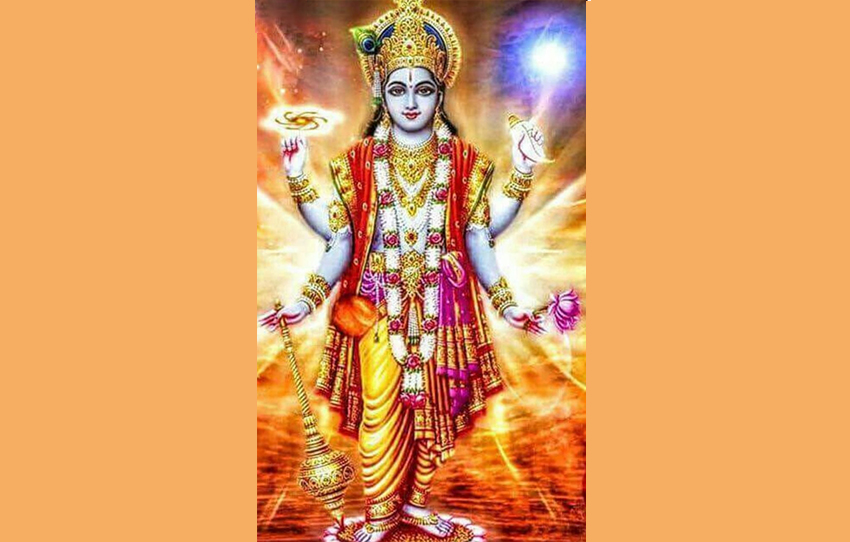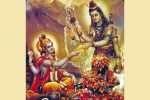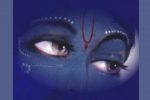NAME 39
Ādityaḥ आदित्यः
Though Ādityaḥ generally mean all the gods, in particular it means the Sun. Sun is always worshipped as god, as Brahman’s self-effulgence is described in terms of sun’s brightness. Brahman alone is Self-illuminating and the sun derives its light only from Him.
Kṛṣṇa said, “I am the radiant sun among the luminaries.” (Bhagavad Gita X.21). There are twelve sons of Aditi, wife of sage Kaśyapa and one among them is Viṣṇu.
Aadityah – One who is the Golden hue in Sun’s orb
This Nama can be interpreted in 3 ways.
a) The Purusha in the Sun – MahaVishnu is the central energy of the Sun. Adi Sankara explains this as “‘Aaditya Mandalaantasthah Hiranmayah Purushah – the golden person present at the centre of the Sun’s orb”;
b) One of the twelve Aadityas. Aditi the wife of Sage Kashyapa had 12 sons called Aadityaas. They are Vivasvaan, Aryamaa, Pooṣha, Tvaṣhṭaa, Savitaa, Bhaga, Dhaataa, Vidhaataa, Varuṇa, Mitra, Śhakra, and Urukrama. Out of these the last named Urukrama is the Avataar of Vishnu.
In Bhagavad Gita, Chapter 10 Verse 21, Bhagavan says “AadityaanaamahamVishnuh” – I am the Vishnu (Urukrama) among the Aadityaas.
आदित्यानामहंविष्णुर्ज्योतिषांरविरंशुमान् |
मरीचिर्मरुतामस्मिनक्षत्राणामहंशशी || 21||
ādityānāmahaṁviṣhṇurjyotiṣhāṁraviranśhumān
marīchirmarutāmasminakṣhatrāṇāmahaṁśhaśhī
BG 10.21: Amongst the twelve sons of Aditi I am Vishnu; amongst luminous objects I am the sun. Know me to be Marichi amongst the Maruts, and the moon amongst the stars in the night sky.
Shri Krishna says that Ishvara is “Ravi”, the sun, among all the bright objects in the universe. He uses the word “anshumaan” meaning radiant to describe the sun. So whenever we see the brilliance of the sun, our mind should immediately go towards the might of Ishvara that is shining through the sun. And just like Ishvara’s luminosity is present in the sun during the day, it is present in the moon during the night.
c) One who sustains and nourishes everything like the Sun.
३९. ॐ आदित्याय नमः।
39. Om Ādityaḥ Namah
Aadityah-The Truth (Purusha) that glows with a golden splendour in the solar system is called Aadityah. There are twelve Aadityas and of them One is called Vishnu.
Krishna Himself declares, ‘I am Vishnu among the Aadityas’ -AadityaanaamAhamVishnuh- (Geeta Ch. 10, St. 21).
The word Aaditya can mean ‘Son of Aditi’-signifying the one who was born as the son of Aditi in His Vaamana incarnation.
The term Aadityah can also mean in Sanskrit ‘One who is like the sun’. The Sun is the one who illumines all, and every living creature draws its nurture and nourishment directly or indirectly always from the sun alone. In the same way Brahman is the one Sun in the universe of living creatures illumining all experiences of all creatures.
Bg. 10.21
आदित्यानामहंविष्णुर्ज्योतिषांरविरंशुमान्।
मरीचिर्मरुतामस्मिनक्षत्राणामहंशशी॥२१॥
ādityānāmahaṁviṣṇur
jyotiṣāṁraviraṁśumān
marīcirmarutāmasmi
nakṣatrāṇāmahaṁśaśī
Translation
Of the Ādityas I am Viṣṇu, of lights I am the radiant sun, of the Maruts I am Marīci, and among the stars I am the moon.
Purport
There are twelve Ādityas, of which Kṛṣṇa is the principal. Among all the luminaries shining in the sky, the sun is the chief, and in the Brahma-saṁhitā the sun is accepted as the glowing eye of the Supreme Lord. There are fifty varieties of wind blowing in space, and of these winds the controlling deity, Marīci, represents Kṛṣṇa.
Among the stars, the moon is the most prominent at night, and thus the moon represents Kṛṣṇa. It appears from this verse that the moon is one of the stars; therefore the stars that twinkle in the sky also reflect the light of the sun. The theory that there are many suns within the universe is not accepted by Vedic literature. The sun is one, and as by the reflection of the sun the moon illuminates, so also do the stars. Since Bhagavad-gītā indicates herein that the moon is one of the stars, the twinkling stars are not suns but are similar to the moon.
INTERPRETATION GUIDED BY SANT VANI (WORDS OF SAINTS)
Ādityaḥ
The one, who obtains in the sun’s orb as golden coloured.
The physical sun is shining and in the morning makes the whole world manifest by its light (Āditya-mandala-antasthahhiraṇmayaḥpuruṣahādityah) –Thus it is a source of blessing to all.
The sun is an example by which we can understand the prakāśa-svarupa, the caitanya-svarupa of the Lord. Therefore, the śāstra gives the physical sun as a locus to meditate upon the Lord, as golden coloured.
What is it that lends the brilliance to the sun? It is nothing but Paramesvara Himself, who is manifest as the sun and lends light to the sun. The sun is the centre of the solar system. So too, the Lord is the centre and without Him, there is no activity at all. Therefore, the Lord is called Āditya. The Taittiriyopaniṣad points to the Lord as ‘yah ca asauāditya, the one who resides in the sun’ and then says, ‘the one who is in the sun, yah ca asaupuruṣe, the one who is in the individual, saekah, both are one and the same’(2.8.5).
Aditehakhanditayahmahyahpatihādityah–here, aditi is māhi, the earth. As the Lord of the akhanditaaditi, the undivided earth, He is Āditya, that is, He is the Lord of all life also. In the absence of the physical sun, there would be no life on earth and a possible ice age.
Dvadasa-adityesuviṣṇuh– He is Viṣhṇu among the twelve adityas. It is said that there are twelve aditya-devatas and among them, one is known as Viṣhṇu. Bhagavan says, ‘among the āditya-devatas, I am specially manifest in the Viṣhṇu-devata.
aditya-sadharmyatvaadityah–Since, He is like the sun, He is called Āditya. Even though the sun is one, it appears as many, because of many reflecting media. Similarly, there is only one atma. This atma becomes the kśetrajña in all the different kśetras, bodies As the kśetras are many, the kśetrajña appears as though many. In every śarira, in every buddhi, there is reflection of the atma-caitanya. Therefore, as the buddhis are many, the reflections of the atma, are also many, even though the atma is only one. Just as the one aditya seems to become many, the one atma appears to become many and hence, He is adityahivaadityah – He is like the sun and therefore, Aditya.
Sun is worshipped as the Savitur Gayatri. Meditating with Gayatri Mantra on the solar plexus – the Manipur Chakra can help build intuition and good health.
Please listen from 12.45min to 14.33min
The one mastering the Gayatri Mantra becomes Shadgunyaparipurna and becomes one with the Lord himself.
Please listen from 9.44min till the end.
The Kartik Maas Surya Sadhna given by Swami ji builds profound intuitive capabilities. Such is the power of the Sun.
https://os.me/gurukula/sadhana-for-intuition-and-wellbeing-2/
The famous Madan Mohan Temple in Sri Vrindavan dham is situated atop a small hillock, which, during the time of Krishna’s pastimes in this world, was located right at the banks of the river Yamuna. This hill has a beautiful story related to it, that transpired after the famous pastime of Krishna killing the poisonous serpent Kaliya. After having fought and subdued Kaliya in the waters of the river Yamuna, when Sri Krishna came out of the river, he was soaking wet and was therefore feeling cold. He climbed up this hill and sat here to dry himself under the sun. At that time, in order to relieve Shyamsundar of his cold, 12 suns appeared in the sky and shined down on the hill to give Krishna warmth. Because of the appearance of 12 suns over here for the pleasure of Sri Krishna, this hillock became well known as Sri DwadashadityaTila. Due to the heat of the 12 suns, Vrajendranandan Krishna started perspiring and the ghat where his sweat was collected came to be known as Praskandan ghat. Indeed every nock and corner of Vrindavan is a store house of the sweet pastimes of Lilanidhi Sri Shyam.
Aditya Hridayam–
The Heart of Aditya (the Sun God) – Sundara Khanda, Valmiki Ramayanam Aditya = the Sun God; Hridayam = that which is especially nourishing and healing for the heart. Sage Agasthya Muni gave this powerful Mantra to Sri Rama when Rama was perplexed, while fighting with Ravana. After chanting this Hymn three times Sri Rama defeated Ravana. The Aditya Hridayam, is a hymn in glorification of the Sun or Surya and was recited by the great sage Agastya to Lord Rama on the battlefield before fighting with Ravana. This historic hymn starts at the beginning of the Battle with Ravana, when Lord Rama is fatigued and getting ready to fight. The mystical hymn is dircted to the Sun God, the illustrious lord of all victories.
“What Arjuna saw was indescribable, yet Sañjaya is trying to give a mental picture of that great revelation to Dhṛtarāṣṭra. Neither Sañjaya nor Dhṛtarāṣṭra was present, but Sañjaya, by the grace of Vyāsa, could see whatever happened.”
BG 11.12, Translation and Purport:
If hundreds of thousands of suns were to rise at once into the sky, their radiance might resemble the effulgence of the Supreme Person in that universal form.
What Arjuna saw was indescribable, yet Sañjaya is trying to give a mental picture of that great revelation to Dhṛtarāṣṭra. Neither Sañjaya nor Dhṛtarāṣṭra was present, but Sañjaya, by the grace of Vyāsa, could see whatever happened. Thus, he now compares the situation, as far as it can be understood, to an imaginable phenomenon (i.e., thousands of suns)



